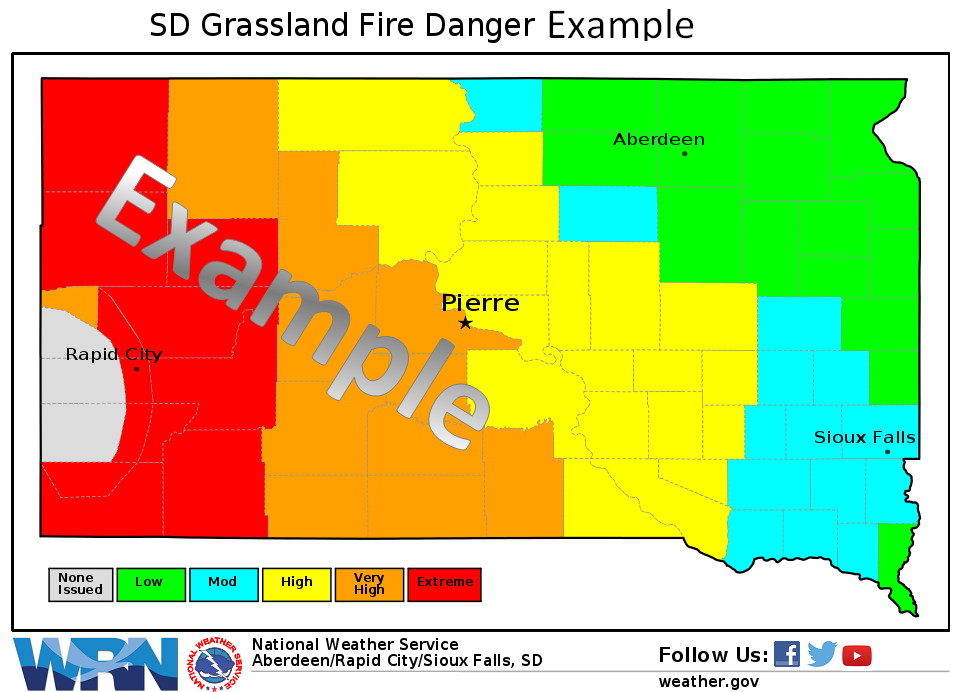
Well above average temperatures will prevail across the Plains and the West Coast this week, while a cold front will bring Arctic air to the South and East Coast Thursday and Friday. Lake effect snow is forecast downwind of the Great Lakes through Thursday along and behind the Arctic front, as well as mountain snow across the Southern Appalachians. Read More >
The Grassland Fire Danger Index is a forecast of the potential for non-agricultural grasslands to carry fire. It provides an indication of fire potential for grasslands, including its ability to spread. The index contains five categories: Low, Moderate, High, Very High, and Extreme. Should a fire ignite, it is more likely that it would grow or spread during higher rating days.
Each NWS office in South Dakota (Rapid City, Sioux Falls, and Aberdeen) issues the Grassland Fire Danger Index daily during the fire weather season, which typically runs from April 1st to October 31st (see Figure 1 for an example). During the non-fire weather season, it is only issued if the High, Very High, or Extreme categories are expected.
The Grassland Fire Danger Index is based on a mathematical formula that uses temperature, relative humidity, wind speed, and curing data. Curing is related to the “greenness” of the plant material. Cured grasses (see Figure 2) contain less moisture and typically will burn much more efficiently than green grasses. Wind speed often has the greatest effect on the overall fire danger for grasslands. Therefore, even on hot and dry days when grasses are cured, it is difficult for the fire to carry at very high rates of speed if the winds are not particularly strong.
Temperature, relative humidity, and wind can vary greatly from day to day. Since the formula used to compute the Grassland Fire Danger Index includes temperature, relative humidity, and wind, it is a bit easier to understand how the Index can change fairly easily from one day to the next.
Here is an example: Let’s say it’s late in the summer and grasses are fully cured. It will be hot, dry and windy this afternoon with temperatures in the mid 90s and a minimum relative humidity around 15 percent. This scenario would likely lead to a Very High or Extreme Grassland Fire Danger Index. Cloudy and much cooler conditions are expected tomorrow behind a cold front, with highs in the 60s and a minimum relative humidity around 45 percent. Winds will be light and variable in the afternoon. Even though grasses are still fully cured, the Grassland Fire Danger Index will be much lower on the second day due to the big change in weather conditions.
Low: Favorable weather conditions and a high moisture content of grasses, and other dry organic material on the ground, indicate that the probability of a fast moving fire is low. Outdoor burning under these conditions can usually be performed with reasonable safety precautions.
Moderate: Marginal weather conditions and lowering moisture content of grasses, and other dry organic material on the ground, indicate that there is some potential for a fire to spread. Any outdoor burning should be closely monitored.
High: Unfavorable weather conditions and low moisture content of grasses, and other dry organic material on the ground, indicate that there is high potential for a fire to spread. Outdoor burning should be restricted to early morning or evening hours when wind speeds are usually lower and the relative humidity is higher.
Very High: Very poor weather conditions and very low moisture content of grasses, and other dry organic material on the ground, indicate that dangerous burning conditions exist. Fires will spread rapidly and show erratic behavior. Outdoor burning is not recommended.
Extreme: Extreme weather conditions and very low moisture content of grasses, and other dry organic material on the ground, indicate that critical burning conditions exist. All fires have the potential to become large and spread quickly becoming erratic with extreme behavioral characteristics.

Figure 1: Graphical example of the Grassland Fire Danger Index